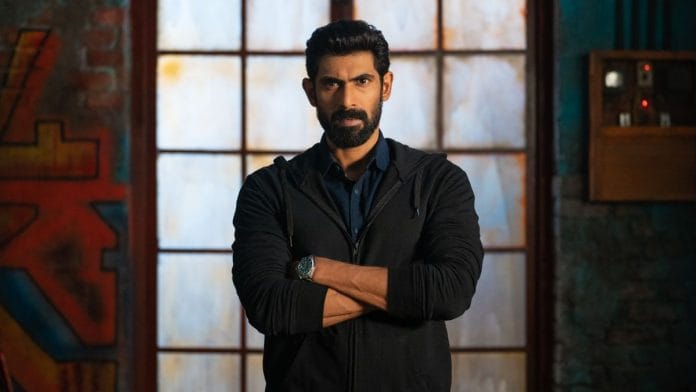New Delhi: Actor Rana Daggubati denies that there’s any divide between the Hindi and South film industries now. According to him, integration was always possible—it just took some time.
“Back when I was working on Dum Maro Dum, I used to say, ‘Let’s make films that work in both languages.’ No one took it seriously then. And now, everyone’s doing exactly that,” Rana told ThePrint, during promotions for his upcoming web show Rana Naidu 2.
Directed by Karan Anshuman and Suparn Verma, Rana Naidu returns for a second season on Netflix. The web show, available in Hindi and Telugu, is an Indian adaptation of the American series Ray Donovan.
It features Rana and his uncle Daggubati Venkatesh in roles originally played by Liev Schreiber and Jon Voight. The show explores the intense dynamics of the dysfunctional Naidu family—internal rivalries, external chaos, and the larger political forces constantly tearing them apart.
The first part of the series made headlines as the only Indian title to feature in Netflix’s global top 400, ranking at 336. The data came from Netflix’s report on viewership across nearly 18,000 titles.
“India is a very diverse country, so it takes time to fully understand what people want. But once you do, the possibilities are massive,” he said.
He credits the internet for helping bridge these gaps and promoting broader acceptance across regions.
“For a decade while I was working in Bombay, people would say, ‘That’s Rana from Chennai.’ They knew a flight went from Bombay to Madras, so they assumed we all came from there,” he recalled with a laugh.
Now, he said, things are evolving.
“Yes, these conversations are happening more often now—and that’s a good thing. Because now, at least, we know better,” Rana added.
Also read: New Bollywood film to bridge the north-south divide—a Janhvi & Sidharth romcom ‘Param Sundari’
What defines adult content?
Rana Naidu sparked controversy for its explicit language and ‘adult’ content, with some viewers feeling it was excessive.
Responding to the chatter, Anshuman said, “Adults found it too adult, which doesn’t make much sense. If adults are uncomfortable with adult content, perhaps they need to switch to something more toned down.”
Rana also put out his perspective on shifting cultural norms in storytelling.
“I’m always questioning what defines our social culture,” he said. “There is a film where I cut the head off this bad guy, and the head came down as a football bouncing on the stairs, you would have clapped… I have seen heads being cut off and people clapping in theatres.”
According to Anshuman, the second season of the series dives deeper into mature, emotional themes, especially between a father and son, which makes the narrative more relatable. It’s a theme Anshuman resonates with and hence, keeps going back to it.
“The idea is to keep the relationships real. The fact that there is some action and gruesomeness — it just means you are highlighting those emotions and taking it to the next level,” he said.
The upcoming season also introduces new characters, including Alia, played by Kriti Kharbanda.
Recalling her experience, Kharbanda called the first season “one of the best shows” she’s seen. “It hasn’t aged because it’s very real, authentic, you do take cinematic liberty, everything is magnified a little bit. But the core is authentic and honest,” she said.
“I knew Karan (Anshuman) was going to make this character so memorable. He has given me some of the best lines of my career. There is a trajectory to her character. A lot of thought has gone behind it — even what watch she will wear,” Kharbanda said.
She added that OTT platforms have given space for women characters to be more nuanced.
“Women are finally getting more complex roles. The format is long, therefore there is time to give time to these characters to evolve. And, I am grateful. The filmmakers are using this opportunity to develop each character,” Kharbanda said.
Pressure of the sequel
Second seasons are often the toughest test for web series, with audience expectations soaring and pressure to deliver intensifying.
However, Rana remains unfazed. He’s confident that his character has grown organically, as the storyline progresses into its next chapter.
“The evolution came in the writing itself. In the first part, you saw Rana fixing a lot of problems quickly, getting things done. This season gets personal — mend and fix relations within the family,” he said.
Anshuman, too, is well prepared to meet the expectations of the fans. The pressure of the sequel is lifted from his shoulders as the filmmaker sticks with a classic and simple formula.
“All we really have to do is to keep innovating, experimenting with the writing and keep pushing the boundaries,” he said.
Rana also hinted about the introduction of another family — the Oberois — as part of the second season.
“If one dysfunctional family wasn’t enough, now there are two. So, that has brought a lot of newness to the script. And, of course, a big antagonist,” he said.
Grey characters, like that of Rana, are the easiest to write rather than a knight in shining armour, according to Anshuman.
Rana, over the last couple of years, has portrayed multiple dark and flawed characters — from Bheemla Nayak and Virata Parvam to Vettaiyan and Spy. But it has never been intentional.
“Usually something lands up and I see if it’s something exciting to do or not. People with complexities have a lot more to play on screen, as compared to a character with a simpler trajectory,” he explained.






